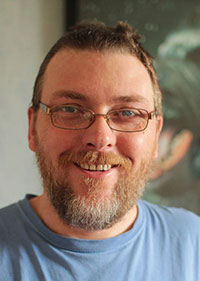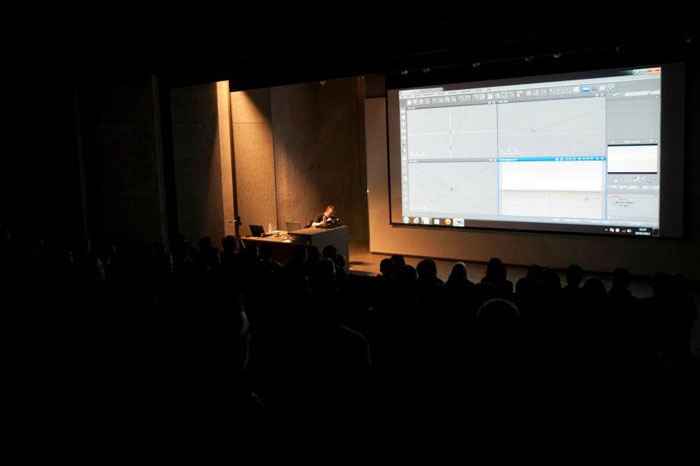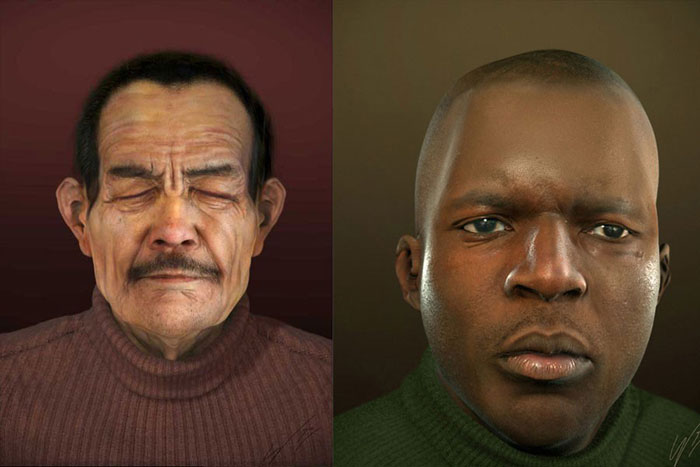نسخه فارسی
Interview by: Amid Rajabi

Hi Wayne,
Hope you’re doing well. Please tell us a little about yourself that how you got interested in 3D and how it all began.
Well I had a couple of things that could be said to be the 'start'. Firstly when I was 1st living on my own and had moved out from my parents house I was stuck in this nice flat, but with nothing to do. A mate of mine came over with an early version of 3Dtudio max that the games firm he was working for were throwing away as they were upgrading. He gave it to me to give me 'something to do'. After 2 weeks trying to learn 3d from scratch from the now notorious early 3d max help files, I gave up. (This was in the days when there was nothing even remotely helpful on 3d online.)
So when My mate Phil came back a couple of week later and asked how I had got on I threw the CD at a wall uttered a string of expletives and told him 'it'll never catch on'. Obviously I was so far from the mark on that I couldn't have been more wrong if I had been trying. (I also had quite a temper back in those days lol)
The 2nd and probably the proper start to 3d for me was all down to Star Wars. I was always a massive star wars fan, and while following the leaks about the makings of the phantom menace I noticed on a forum a young guy had posted a 3dmodel of Darth Vader's helmet. it was very good, the only problem was I knew it was a model he had simply downloaded from a star wars model site that all fans knew about at the time. So after pointing out that you can't just claim other peoples work as your own I say talking to my brother later that night and said probably the stupidest thing I have uttered in my entire life.
"Hey this 3d lark looks pretty easy...I mean how hard can it be? its only pressing buttons right? I think I'll give that a go."
That one incredibly wrong statement lead me to learning 3D... I found I liked it and so far I've never stopped. Its sent me on a lifelong journey that is now a very large part of my life, both for work and pleasure.

You’re specifically known as one of the best Modelers in the world. How did you choose Modeling as your main profession?
To be completely honest I didn't chose art as a profession...it chose me. Although I'd had an interest in art and sculpture from an early age, coming from a tiny town about as far away from the 3d world as you can get it wasn't eve on my radar. I would never be so arrogant as to either call myself or see myself as 'one of the best modelers in the world'. I just do what I do and will keep on doing it for as long as I keep enjoying it. There is no point where you can ever say 'ok. I know everything about 3d now'.
I've always said there are far easier and less stressful ways to make money than being a 3d artist. We all often work long unhealthy hours and for far less pay than any profession with an even remotely similar learning curve. But most of us do it not for the money, but because we love it and we have to. It's what drives us... and we cannot ignore that drive no matter how we try. I can count on one hand models that of mine that I can even stand looking at a week after I've completed them. All I see are the faults....sometimes you have time to put some of them right (then you see another load of new problems), and sometimes time is against you. Art isn't released...it escapes.

You’ve chosen “Mudbox” in comparison with “Zbrush”. Can you tell our readers about the reason to choose that SW?
I always say that each artist must find the tool that works best for him and suits his style best. It's no different to 2D artists having a favorite make of marker pens or a grade of pencil they favor for sketching. While you never see 2D artist arguing over who's pencil is best, you do with 3D artists. I started sculpting in Zbrush, released 32 DVD's teaching it and an incredibly long book. I'd used Mudbox before back in its very early Skymatter days but had switched back to Zbrush as Mudbox at that time was dead in the water for a couple years after it was bought out by Autodesk.
As far as we all knew at the time Mudbox was dead and there was no visible future in it. So when I got an email out of the blue asking if I wanted to take part in the beta testing for what would eventually become Mudbox 2009 I actually had second thoughts and nearly said no. I'd just completed my Zbrush book and to be honest after a year of sitting looking at it 20 hours a day I had gotten sick of the sight of it, for no other reason than I had been living with it night and day for a year.
I didn't expect the beta of Mudbox 2009 to be any good, in fact I went in specifically expecting to hate it. So I was floored when I found it felt better to me and worked for me better as an artist than Zbrush did! It's been my main application for sculpting ever since. When Mudbox 2009 was eventually released, as fate would have it, it came out the exact same day as my book on Zbrush was finally published. Now many thought this was a deliberate ploy of some kind, it wasn't. My publisher had held the book back for 6 months in hope of a new Zbrush release he was convinced would come around thus helping sales. (obviously it didn't see a new release around then.) But as a result I got more fan boy hate after it came out the same day as Mudbox 2009 than the nets seen in a few years. Thankfully this has calmed down a heck of a lot in recent years.
Now this is not to say I don't still use Zbrush, I'd be a very stupid guy if I stuck to just one sculpting app and stuck to Mudbox out of some sense of loyalty. In fact I use all of the 3 main sculpting apps in some point in my pipeline so while Mudbox has a very big part, both Zbrush and 3D Coat also have parts. I use applications to their strengths not their weaknesses, (which all apps have.) People sometimes forget that it is all software firms job to sell their software. They will always talk up their product and talk down the oppositions. It's down to artists to try them out and find out if something is right for them or not. I've said since day one, that if Mudbox ever stopped doing what I need it to do I'd stop using it in a heartbeat. As a freelance artist, I cannot afford to stick with something out of brand loyalty at the expense of feeding my wife and kids. But Mudbox continues to do what I need it to. My advice to all artists is believe your own experiences not the hype by any company or fans of any app. All applications have things you'll like, and things you'll hate. You just have to work out what ones you can live with and what you can't. Anyway that's my advice for what its worth.

What other SW you’re working with in general regardless of Mudbox? What are your reasons to choose those SW?
While sculpting often gets seen almost as the 'rock star' of 3D, the vast majority of what I do on a day to day basis is not sculpting based. So as well as Mudbox, I also use a lot of other applications, 3dmax is always at the core of things for my own personal pipeline. Along with Headus UVlayout, Maya, Vue of course and specialist apps for a certain part of my pipeline like Topogun for retopology, 3D Coat and many more. Also as a programmer I write many of my own apps and plug-ins to fit in particular parts of my pipeline to solve a problem. Some of these from time to time I release to the public (such as the Vector Displace shader which was the 1st of its kind for mental ray, or MudWalker which was the first thing to allow people to send models and textures in a single click to and from many applications....I find it ironic that MudWalker had support for more apps in the 1st week of its life than many that followed it ... now 3 years later lol.)
I don't release software that I write as much these days as to be honest got into 3d to do art not to be tech support. So should I release anything in the future (which may or may not be pending), chances are it'll be both free and totally without tech support. I also never give warnings if I'm about to put something out software or plug-in wise.
Which companies do you co-operate recently? What are your current projects?
Recently most of my time has been spent this year on the MOD302 3D digital environments course for FXPHD which I'm just about to record the last week for at the time of writing. Outside of this I've been doing work hand sculpting liquids in Mudbox for a large drinks firm . (There are times when a 100% match to concept art is needed and a fluid simulation won't even get close... ). There's also been articles for magazines, stuff for TV shows and some things I can't talk about yet due to N.D.A's.
I've also got a few personal 3d programming projects I am itching to find time to finish off. In fact a week ago I put a video up of what is probably the only voice operated copy of Mudbox on the planet. which I created for live lectures and speed sculpting to free my hands up. So I'm rarely sitting resting, I'm always busy with something.
What did you feel the day you’re chosen as Mudbox Master from Autodesk organization? How did this title impact on your career?
Well it was a huge surprise as I never thought in a million years I would get the 1st ever Autodesk Master Award to be handed out for digital sculpting. But being the 1st at anything always comes at a price I find. For me the price was it nearly killed off my freelance career as there were a lot of people who thought it should have been them that won. Strangely most of these were not Mudbox users so weren't valid anyway. So it was a mixed bag, yes it gives me something nice to put on my CV and sounds very impressive to people, but bottom line is it's a way of saying 'thank you' and no more. So the world does not suddenly beat a path to your door. Now there is a 2nd Autodesk master for Mudbox at the time of writing my mate Neil Blevins of Pixar who is a very well deserved recipient. I have no doubt this year will see one or two more.
In many ways the Autodesk Masters award forced me to work harder to get better as I needed to feel to myself that I deserved it. You do get a rather nice leather jacket though.
As far as my mind can reach, you’ve had two modeling sessions at FXphd during the past two semesters which I believe were really awesome and fruitful. Would you please tell us a about your experiences in FXphd? What’s your own idea about those classes?
Mike Seymour 1st approached me about doing classes for FXPHD last year around February (2011). We'd been working together on a project for a TV series by a production company owned by a well known British comedy actor. The initial idea was to cover the creation of a small rural church for a short film he is making. I convinced him that not to do a tiny church but a full photo real cathedral interior based on Durham Cathedral near where I live. I was eager to prove I wasn't just a 'Mudbox guy' or a 'creature guy' and that I can do other things.
After I had finished this for MOD301 (and I have to admit it's one of the favorite models that I've done), we started talking about the exterior shots which make up MOD302. So all in all I've been working on shots for this on and off for a year, so although I've enjoyed making the cathedral interior and exterior greatly, I am a little glad I won't have to look at any more Norman architecture for a while. Mike and the guys at FXPHD are a dream to work with and it's been nice to show the things I do outside of the Mudbox stuff. Mikes became a good friend as a result.

Will you have plans to hold other classes in FXphd in the following semesters?
There will no doubt be repeats of MOD301 and MOD302 over the next term or two, nothing is set in stone in regards to more classes, while both them and myself would love to do more it also has to fit around my freelance work. As to be honest that pays a good chunk of my bills lol. The last 2 have been level 300 advanced courses that take up a lot of time to do so that also has to be taken into consideration. So the short answer is maybe...you'll have to wait and see, but nothing is set in stone just yet. But I can tell you the term starting April 2012 I'm having off, although MOD301 is definitely being repeated.

Can any artist be a good teacher as well or not?
There's a difference of opinion on this to be honest. I think anyone who has the ability to be able to take sometimes complex concepts and break them down to into much easier to understand ideas can yes. Some people seem to find this far easier than others. The old 'those who can ...do, those who can't....teach' is to be honest a load of rubbish. It's a very bad idea to learn from a teacher who cannot produce work of a high quality and with no experience. While you can find diamonds in the rough from time to time, more often than not if a person hasn't reached a certain level themselves then they can pass on as fact things that are incorrect. But this isn't a rule, more of a guideline as I've seen both amazing artists who are terrible teachers and terrible artists who are amazing teachers. So I would make sure whoever you are learning from is the best teacher and artist you can find that works for you. not every style of learning works for every student. A good teacher can read a classroom or lecture and tailor to their needs without blinking.

How do you update your functional data? What are your used resources?
Reference to me is always king, without it your grasping in the dark, yes sometimes you can hit onto a seam of artistic gold, but more often than not you end up with something that needs a lot of clean up. For example if your sculpting a creature that doesn't exist, then you have to base this off real world anatomy. While there not really be 16 legged aliens with 14 eyes from the planet Zog we can pull as reference, you can construct an anatomy based on animals and creatures that are. But sometimes there is a part of the anatomy missing that has no equivalent, then you have to make something up that while obeying the rules of anatomy fits in and looks good. A couple of years back I had to create for a shot in a feature film a human leg but with the foot on backwards...also the entire leg was on backwards and the left foot was on the right leg, and the right foot was on the left leg. This meant constructing an entirely new anatomy and muscle structure for the backwards foot on the wrong leg and the hip area. As once you stick a foot on backwards the standard human anatomy falls apart a fair bit. That took a while to solve. But the result was photo real and worked well as it was based in reality.
While it can take many hours of drawing complex anatomical and skeletal sections before getting anywhere near modeling or sculpting, I work it out in my head as sort of a blurry turntable. This is mainly as my drawing is pretty ordinary, and secondly I find it faster and I can update this 'internal anatomy' of the creature as I sculpt should I come across a problem area. For either textures or the surface of things be they animal or architectural, then photos are your friend. For example the cathedral interior and exterior of Durham cathedral in did for MOD301 & MODS302 needed literally thousands of photos, measurements and drawings. Sometimes though reality needs a helping hand.
There are so many trainees who really like to learn modeling and they’re eager to find the right way. What is your advice for them? How do they start and how do they move forward?
A common mistake is to either try to learn everything at once and then become so confused you stay in a sort of learning stasis skill wise for years; or to learn from people who are only starting out themselves. learn the basics first and learn them well as these are your foundation and if your foundation is badly built...then the house you build on it is going to fall down eventually. Learn to weed out the information you need to know from the stuff that is way too model specific. So learning the concepts from a tutorial and then being able to apply them to a model of your own is far more valuable as a learning experience than just making exactly the same 'cool model' as everyone else. Make sure you know the 'why's as well as the 'how's'. I cannot stress how important it is to learn why something is done as well as how it is done.
I can't say I envy those starting out now as it's a far longer road to when I started out and the industry was still very new. They have a long journey ahead of them.
What’s your idea about CGphd website and its online trainings? What’s your evaluation?
new good quality 3D training will always have a place in this industry, although these days I rarely have time to keep up with them. as most tutorials are in English you get extra brownie points for not restricting yourself to just the English language....so keep up the good work.
We’re really appreciated for your time in advance.
It has been a pleasure talking with you guys. Keep up the good work.